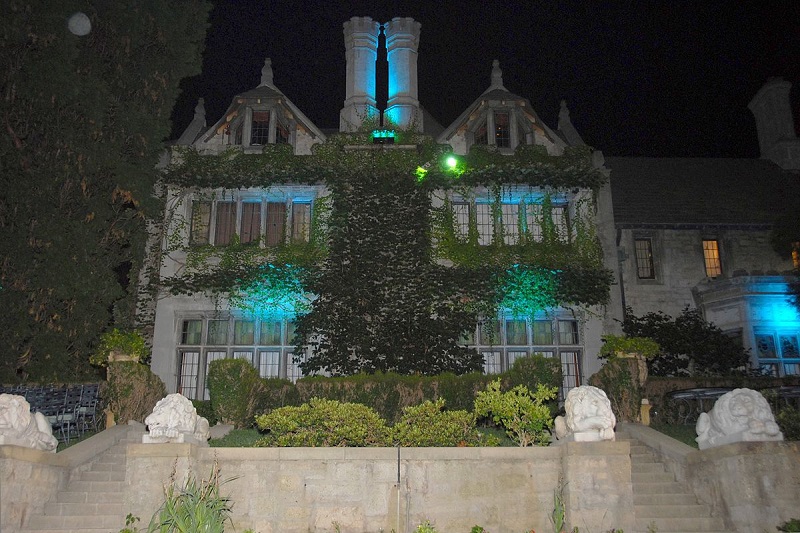Main author
Michael BrooksPlayboy Mansion
Contents |
[edit] Introduction
The Playboy Mansion was the iconic residence of Hugh Hefner, founder of the Playboy magazine empire. Located in Holmby Hills, Los Angeles, it is one of the most famous mansions in the world, notorious for its decadent and lavish parties.
Construction of the mansion began in 1927. It was bought by Hefner in 1971, and became his full-time residence in 1974, when he moved from the original Playboy mansion in Chicago. Hefner purchased the mansion for $1.1 million from Louis D. Statham, an engineer, inventor and chess-master.
In 2016, the property and its 5.3 acres of land were put on the market for $200 million, making it one of the most valuable estates in California. It was eventually bought for half that amount by Daren Metropoulos who stated his intention to renovate and restore the mansion to its original form.
[edit] Design and construction
The 2,048 sq. m mansion was designed by the architect Arthur R. Kelly in the Gothic and Tudor Revival styles. Hefner has described it as resembling an English country manor.
The mansion contains 22 rooms, including six bedrooms, six baths and two powder rooms. The estate also includes a 4-bedroom Aviary greenhouse which acts as a guesthouse and a 2-bed games house.
Some of the features of the mansion include a wine cellar accessed via a Prohibition-era secret door, a screening room with pipe organ, and extensive carved-oak décor which dates back to the 1970s. The west wing of the mansion contained the editorial offices of Playboy, while the extensively renovated Master’s suite is located across several rooms on the second and third floors. Throughout the rest of the mansion, the original Gothic Revival furnishings are maintained, including an oak-panelled drawing room with open fireplace.
The landscape is equally lavish and includes a tennis/basketball court, a swimming pool with patio, a basement gym and sauna, a large koi pond with artificial stream, a citrus orchard and two forests of tree ferns and redwoods. Perhaps most famous is the artificial waterfall and stone grotto containing several whirlpool hot tubs.
It is one of the only residential properties in the Greater Los Angeles area to hold a zoo licence and as such, the estate contains three zoo buildings with exotic birds, squirrel monkeys and rabbits.
[edit] Post-construction
The mansion is currently used for corporate activities, charitable events and civic functions.
Due to its iconic status and close proximity to Hollywood, the mansion has become a symbolic backdrop in magazine photography, as well as numerous films and TV programmes, including ‘The Fresh Prince of Bel-Air’, ‘WWE Smackdown’, ‘The Apprentice’, ‘Beverly Hills Cop’, ‘Sex and the City’, and ‘Curb your Enthusiasm’.
In 2011, a widely-reported incident occurred in which 123 people suffered with fever and respiratory illnesses after a corporate event. Investigators found that the virus outbreak was Legionnaire’s Disease spread from bacteria that was traced back to one of the grotto’s hot tubs.
[edit] Find out more
[edit] Related articles on Designing Buildings Wiki
Featured articles and news
Latest Build UK Building Safety Regime explainer published
Key elements in one short, now updated document.
UKGBC launch the UK Climate Resilience Roadmap
First guidance of its kind on direct climate impacts for the built environment and how it can adapt.
CLC Health, Safety and Wellbeing Strategy 2025
Launched by the Minister for Industry to look at fatalities on site, improving mental health and other issues.
One of the most impressive Victorian architects. Book review.
Common Assessment Standard now with building safety
New CAS update now includes mandatory building safety questions.
RTPI leader to become new CIOB Chief Executive Officer
Dr Victoria Hills MRTPI, FICE to take over after Caroline Gumble’s departure.
Social and affordable housing, a long term plan for delivery
The “Delivering a Decade of Renewal for Social and Affordable Housing” strategy sets out future path.
A change to adoptive architecture
Effects of global weather warming on architectural detailing, material choice and human interaction.
The proposed publicly owned and backed subsidiary of Homes England, to facilitate new homes.
How big is the problem and what can we do to mitigate the effects?
Overheating guidance and tools for building designers
A number of cool guides to help with the heat.
The UK's Modern Industrial Strategy: A 10 year plan
Previous consultation criticism, current key elements and general support with some persisting reservations.
Building Safety Regulator reforms
New roles, new staff and a new fast track service pave the way for a single construction regulator.
Architectural Technologist CPDs and Communications
CIAT CPD… and how you can do it!
Cooling centres and cool spaces
Managing extreme heat in cities by directing the public to places for heat stress relief and water sources.
Winter gardens: A brief history and warm variations
Extending the season with glass in different forms and terms.
Restoring Great Yarmouth's Winter Gardens
Transforming one of the least sustainable constructions imaginable.


























